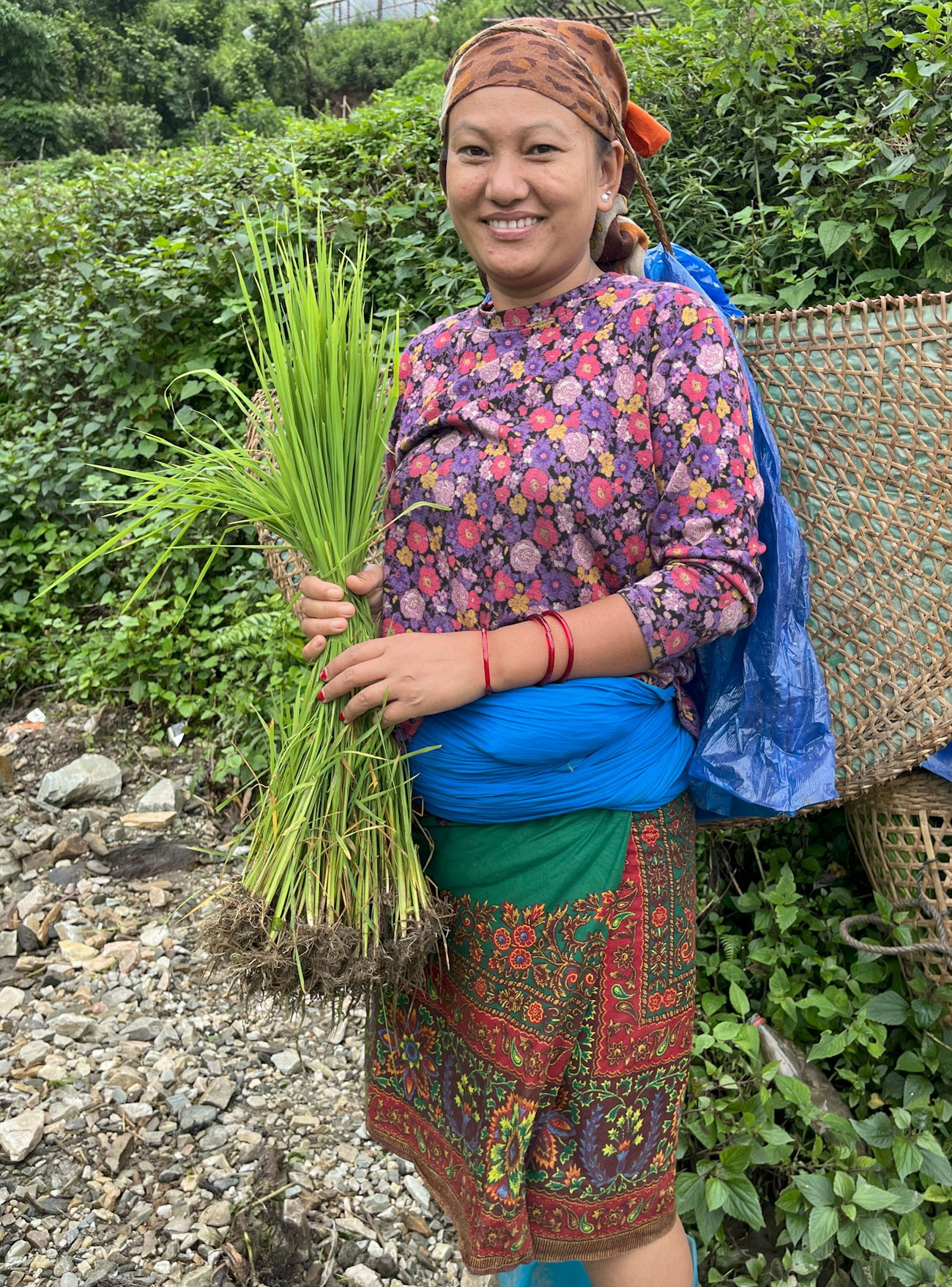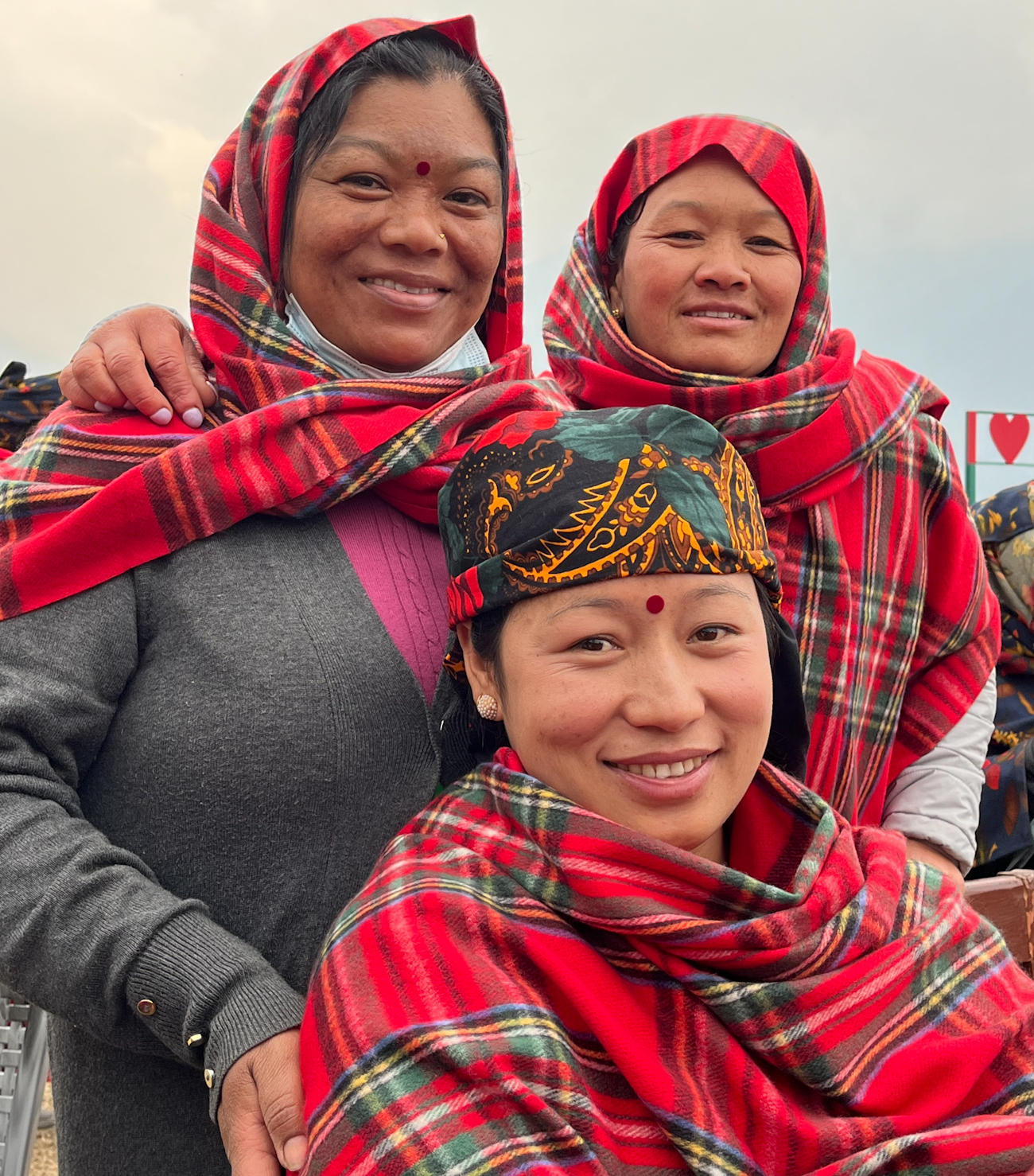Enjoy this exclusive feature as part of our ongoing look at traditional dress around the world. If you have a PieceWork All Access membership, you can read the full story by logging in to your account below. Not an All Access Subscriber yet? Join the community here! Interested in reading more about traditional dress? Check out PieceWork's Winter 2025 issue today.
A Himalayan Village
On a steep hillside in the Annapurna range of the Himalayas, the village of Ghandruk has thrived for more than three hundred years. Earth and stone homes with slate roofs intermingle with modern hotels. Flourishing kitchen gardens and meandering stone pathways give way to terraced rice and millet paddies stretching down the hillsides to the Modi River below. Snow-covered peaks of the Himalayas tower above.
Most of Ghandruk’s four thousand residents are Gurung, a hardy people who migrated gradually from Mongolia into Tibet and eventually over the high peaks to settle in the valleys of the Annapurna mountains more than two thousand years ago. Each valley in this mid-hill region evolved somewhat independently, and the people of each community developed their own dialects of the Gurung language and slight variations of traditional dress.
Everyday Dress
Today, in many Gurung villages across the Annapurnas, clothing is increasingly influenced by the West as well as urban Asia. However, the everyday dress of women still reflects much of past traditions. This includes a lungi, a tubular skirt tied at the waist with a very long, narrow cotton belt, often blue, called a patuki. Tops vary from T-shirts to sweaters to the traditional chaubandi cholo, a short, high-necked blouse fastened with four ties across the chest. The women almost always cover their shoulders with a large shawl, or pachauri, and a head-cloth, also called a pachauri, which they gather in a knot at the back.

Women from the Gurung village of Lwang share a laugh on rice-planting day. All wear pachauris on their heads and lungis. The three women in the middle wear cholos and patukis.
Cholo
The chaubandi cholo, the four-tie blouse, may have been woven from cotton and sewn by hand in times past, but over generations, women began purchasing and sewing ready-made cloth. Several years ago, with the construction of a road linking Ghandruk to Pokhara, a large city a few hours away by bus, they started to buy ready-to-wear cholos in a market specializing in Gurung clothing and jewelry. Everyday cholos may be polyester, cotton, or dhaka, the iconic Nepali handwoven cotton brocade.
Lungi
Below the cholo is the lungi, a wide rectangle of fabric sewn into a tube, resembling the sarong worn throughout Southeast Asia. Typically made of Dutch wax-print cotton, the lungi is vibrant and practical. Women gather the cloth at the side of the waist in two or three folds, tuck it into a petticoat—a slip worn underneath—and secure it with a patuki. This long cotton sash wrapped several times around the waist offers lumbar support for hardworking women and functions as a handy pouch for carrying small items. As Lanka, the owner of the Old Gurung Museum in Ghandruk, explains, the patuki is a symbol of “always being prepared for hard work.”

Roshni Gurung from Lwang wears a patuki over her lungi to carry personal items while she works in her rice paddy.
Today, a more modern version of the lungi leaves the fabric open—no longer a tube—and adds waist ties, making it more like a wraparound skirt. Though lungis may once have been made of handwoven cotton, no one in Ghandruk recalls a time before they purchased the fabric for them. The origin of Dutch wax prints in local use also remains uncertain. These prints trace back to the Indonesian batik tradition, which was industrialized by the Dutch East India Company and widely traded across Asia and Africa. Today, imitation wax prints manufactured in India and China are ubiquitous in markets throughout Nepal.
Pachauri
A shawl, or pachauri, is the most consistent aspect of traditional Gurung dress. Whether a woman chooses to wear jeans and a T-shirt or lungi and a chaubandi cholo, she almost always wears a shawl draped around her shoulders with the ends crossed over one shoulder so that her whole upper body is covered. Women and girls wear shawls year-round as protection against cool mountain air, intense sun, or relentless rain. With equal frequency, women wear smaller pachauris wrapped around their heads. In the winter months for extra warmth, they may wear a third shawl wrapped around their waists.
Click any image in the galleries below to explore them in full-screen and read more about each.
Pachauris used to be handwoven of wool and later cotton in the villages, but now women buy them ready-made in nearby Pokhara. They come in varying fabric and designs, from polyester, simple cotton, or a double layer of muslin and flannel to handwoven wool or even cashmere blends. Some pachauris imitate Kashmiri Aari embroidery, which is found throughout Nepal in a mix of hand- and machine-made forms. These shawls come in vivid colors—magentas, reds, and greens are common—and are heavily embroidered in chain stitch in bright wool threads. Another common style is based on Jamawar shawls, also from Kashmir, with mainly paisley motifs woven into the fabric, which ranges from silk to wool. One of the more common designs for a pachauri is the tartan pattern made of a fuzzy polyester fabric or less often a blend of cashmere, wool, and silk.
Why the Tartan?
In 1814, when the British unsuccessfully tried to annex Nepal into the empire, British army officers were surprised by the tenacity of the Gurkha soldiers and encouraged them to volunteer for the East India Company. Gurkhas were composed of Gurung and Magar ethnic groups. A Scotsman serving in the British East India Company recommended that the Gurkhas serve alongside the British soldiers. Over the next two hundred years, Gurkha and Scottish troops fought side by side throughout the world. The 2nd King Edward VII’s Own Gurkha Rifles (2GR) and the Gordon Highlanders are two regiments closely aligned with Gurung soldiers. In 1949, the Scottish Rifles were affiliated officially with the 7th Gurkha Rifles, and to mark the occasion, the regiment invited the 7th Gurkhas to wear their tartan, the Douglas, which they do to this day. The Gurkha Museum Trust created a tartan to commemorate the more than two hundred years that Gurkha soldiers from Nepal have maintained a close relationship with Scottish regiments.

Clockwise from left: Suman, Binu, and Chandra at a festival gathering in Ghandruk wear their tartans for warmth and celebration.
Festival Dress
For festival days and special occasions, women’s dress is similar but follows stricter pattern and color conventions than everyday wear. The chaubandi cholo is usually made of red or blue velvet. Lanka guesses that originally these may have been woven from nettle or cotton. When asked when and why women started wearing velvet, Lanka laughs and says, “Hong Kong.” She explains that soldiers serving in the British army returned to their villages from abroad and introduced certain goods: radios, sewing machines, tartans, and velvets, among other Western conveniences. Decades ago, the standard festival cholo became velvet. The festival lungi is much wider than the everyday lungi. Traditionally, it was 16 feet (5 meters) wide and was pleated several times to hang in folds in front. The pattern for the festival lungi is called chitko gunyo, a simple design of dark blue squares on a light blue, variegated, or speckled ground.
Lanka’s mother told her the design came from Rajasthan, India. The “chit” in the Nepali fabric name may come from the Hindi word chint or chitta, meaning spotted or variegated. Chitta cloth, a valuable trading commodity during the seventeenth and eighteenth centuries, became known as chintz. Later, block printing was used to speed up the painting process for chintz. For about four hundred years, Rajasthan has been a center of block printing, and maybe the Nepal designs originated there. Regardless of the source for the name or design, chitko gunyo is well known across Nepal. A popular love song written many years ago, simply called “Chitko Gunyo” refers to the famous fabric design: "When you wear your chitko gunyo, you make me fall for you unexpectedly. You make me cross the Seti River. How do I calm this sinful heart?”
Women wrap a triangle of black velvet lined with cotton, called a tikish, over their chitko gunyo. The tikish is held in place by a brilliant blue patuki wound several times around the waist. Then, they attach a ghalek—a red or black velvet, cloak-like sash—over the left shoulder. This is sometimes hand-embroidered and now commonly machine stitched. The embroidery is usually in thick gold thread and incorporates sequins, glass beads, and gold bric-a-brac on the hem. Common motifs are flowers, especially the rhododendron flower, as the hillsides surrounding the village are covered with the brilliant red blossoms each spring. Next, women place a folded pachauri over one shoulder and either wrap another pachauri over their heads or wear an elaborate gold headdress called a sir bandi. Around their necks, they wear muga, chunky necklaces of imitation amber or turquoise likely stemming from an age-old Tibetan custom.
Since the Gurungs traveled over the high mountains into their current valleys, they have been adapting. In fact, much of the story of Gurung dress today lies in global influence from other Asian countries and from the West. Still, for dance performances and festival days, it’s with tremendous pride that a woman pulls on her chaubandi cholo, gathers her chitko gunyo around her waist, ties it with a patuki, drapes the ghalek across her shoulders, wraps herself in a pachauri, and adorns her head with the sir bandi and muga around her neck. This act is a celebration of what it means to be a Gurung in the Annapurna of Nepal today.
Click any image below to explore the stunning garments in full-screen and read more about them.
Karen lived for a year in Nepal as a Peace Corps Response volunteer and learned much about traditional dress of the Nepali people. She would like to thank the people of Ghandruk, especially Lanka Gurung and Beena Ghale, for sharing their knowledge.
Resources
Fee, Sarah. Cloth That Changed the World: The Art and Fashion of Indian Chintz. Toronto: Royal Ontario Museum, 2020.
Macfarlane, Alan, and Indrabahadur Gurung. Gurungs of Nepal: A Guide to the Gurungs. Kathmandu: Ratna Pustak Bhandar, 1992.
Nikita, “Aari and Tambour,” PieceWork, Winter 2023, 56–59.
Interested in reading more about traditional dress? Check out PieceWork's Winter 2025 issue to read about folk wear traditions.













